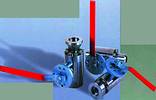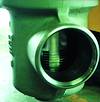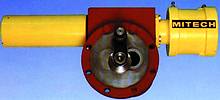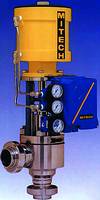
The 1980s saw a period of substantial growth in the South African manufacturing industry, with the launch of many new companies. The more innovative start-up businesses of that era have thrived and one of these is the local control valve manufacturer, Mitech. The current Managing and Production Directors, Michael Sessions and Greg Walker established the company during 1987 as Actuators and Controls. While Mitech was originally the trade name used for the product it became so well known in the process industry that the company now also trades under the name of Mitech.
Both Mike and Greg had extensive knowledge of the valve and actuator business, and this was the niche on which the company focused, growing to become today the largest manufacturer of control valves and actuators in Africa, the turnover in 1999 being in excess of R20 million. Initially, the business was based on developing custom actuators for other makes of valves, but it soon became clear, following demand from customers, that a market existed for locally manufactured control valves, actuators and positioners. While the company has the capability of producing the run-of-the-mill valve types it has also acquired a deserved reputation of being able to design custom valves for the really difficult applications, including those with extremely large pressure drop across the valves.
During these formative years when capital investment costs were high, Mitech, with its solid business plan and strategy, qualified for loans from both the SBDC and the IDC, a fact of which the company is justifiably proud. Despite the support from these bodies, Mitech still had to counter the prevalent perception at that time that "anything made overseas must be better..." They have thus always strived to deliver the best possible product quality and service, the latter being exceptionally high because of its local presence and capability. In really critical situations it has on occasion been possible to turn out made-up valves within 24 h.
The first customers of Mitech were Afrox and Iscor in Pretoria, and from here the company moved into the mining and petrochemical industries, becoming one of the four approved suppliers of control valves to Sasol. From there the business expanded rapidly into other areas of the industrial control industry, including pulp and paper, sugar and chemical. One of the major strengths of Mitech always lay in its ability to design and manufacture locally, and the more specialised the application, the more competitive the state-of-the-art solutions provided.
Mike Sessions believes that Mitech has continued to thrive because they selected the automated control valve niche. One of the company's main areas of specialisation is the globe control valve, which has a major advantage in that it can be engineered and configured to meet virtually every need from the most basic to the most complex. The Mitech globe control valve range is available in sizes ranging from 12 to 400 mm with bodies constructed from materials which include carbon steel, stainless steel, tin-bronze, chrome molybdenum and other special alloys. The internal trim is even more flexible including hardened material such as Stellite or tungsten carbide. A full range of retainers is offered, with features such as cavitation control, low noise and energy dissipation. Diffuser plates, which can be installed downstream of the valve to introduce a backpressure, are also available.
Valve technology per se is fairly mature and R&D at Mitech is always carried out with customers in solving application-specific problems. Companies with which this approach has worked well include Illovo, Samancor, Sasol, SAB, Eskom, Iscor, Tongaat, Sappi, Mondi, Impala Platinum and Anglo, while special, cryogenic valves have been developed for use by Afrox.
As the manufacture of globe valves developed it became clear that pneumatic or electro-pneumatic positioners were also a critical component. Mitech started to develop these positioners in conjunction with its sales manager at that time, Richard Ransome. As a positioner is an instrument and not a valve, it made more sense to design and manufacture these outside of Mitech, and Ransome set up and is MD of the independent company created to focus on this business, namely PC Technology (PCT).

Mitech success stories
In the case of boilers the feedwater valves experience unusual conditions, namely high pressure drop and low flow rates during the start-up phase. This results in undesirable cavitation and damage to the valve seat. Often the solution used in the past was to install a sacrificial valve in parallel to the control valve, which is used only for start-up. Mitech first solved this problem at Eskom's Hendrina power station by developing a control valve that can handle both start-up and running conditions. The key lay in the design of the retainer where the bottom has a series of restrictions, which eliminate cavitation by gradually dropping the pressure. As the plug opens the number of restrictions reduces, thus allowing the valve to handle the high flow and low pressure drop conditions of normal running.
Mitech has a substantial export business and the company's broad base of installed special purpose control valves now means that solutions are available from the historical database. This was the case in a recent requirement in Turkey for an angle control valve for use as a boiler start-up vent valve in a fertiliser company. A similar valve had been supplied some three years ago and this was used as the basis of the design of the valve for Turkey, which had dimensions of 150 x 250 mm and was manufactured from WC6 chrome moly. This valve, one of Mitech's largest export orders, was supplied complete with an energy-dissipating disk stack trim with two diffuser plates and a downstream silencer. Similar valves to this had been provided previously to local ferrochrome manufacturer, Samancor.
Mitech is a distributor for Valvtechnologies from the USA (metal seated ball valves), Valcom (butterfly and nonreturn valves), and the Cashco range of rotary plug control valves and self-regulating valves. All of these imported products are fully supported by the in-house repair facility, minimising down time and cost to the user. The metal-seated ball valves from Valvtechnologies have been particularly useful to Mitech, as these have been designed to operate at extremely high temperatures (up to 965°C) under high pressures in highly corrosive environments. These valves are extremely resistant to catalysts, abrasives and corrosive fluids and have been used locally in applications which involve catalyst slurry, high-density polyethylene and high-pressure ethylene.

Mitech's project approach
Since it began valve manufacture Mitech has concentrated its sales effort mainly on the end user, ensuring that the Mitech brand became established in the plants and that the customers became familiar with both the products and the quality of the back-up service. Some five years ago a Project Branch was established in Johannesburg, the objective being to secure the business from project houses and Head Offices. Since that time this side of the business has grown substantially, and several large projects have been won and successfully completed, some on very short lead times. These projects include:
* LTA - Palmag and pilot plant at Phalaborwa.
* IMS - Samancor project and NCP Isipingo.
* Hatch Africa - Chambishi, Zambia.
* Krupp Uhde - Mossgas.
* Afrox - Pretoria plant extension and the Highveld plant.
* FFE Minerals/DRA - Western Platinum.
Hennie Pretorius, who is Mitech's Sales Manager and is responsible for all project work, believes that the success of a project starts with the careful preparation of the tender. He believes that selecting the correct size and type of control valve at the beginning is the key to ensuring that there are no comebacks after completion of the project. He also believes that the success Mitech has had in securing large projects really does prove that "We are in control".

Manufacturing facilities
Mitech has a very extensive manufacturing facility located in Kya Sand north of Johannesburg. The company was certified to ISO 9001 during 1996, this certification covering design, manufacturing and service. The manufacturing facility has a staff of some fifty people, mostly highly trained artisans and mechanical engineers. A full MRP system is operated which covers order input to final delivery. Total material traceability is maintained (all raw material is kept in separate bays in the store and is colour coded) and the integrated Unix-based system can handle machine shop loading and changes in due delivery dates. Phantom order generation in the system is used to see how best rush orders can be accommodated, while all valve design work is done using a CAD system. While at one time Mitech used to stock the more common valves, the strategy now is to stock only components and to make up complete valves to order. The effectiveness of this approach can be seen from the fact that the stock turns over more than 12 times per year.
While producing valves of up to 400 mm in size is real, serious engineering, the Mitech production facility is the epitome of good work practice, with clean machines and tidy work cells. Unlike a mass production plant the CNC machines typically change jobs four or five times per working day, and large manual lathes and milling machines are available for use on the really 'one-off' orders. One person is responsible for each CNC machine, which discourages the often-found tendency to leave the mess for the next operator to clean up.
Six large CNC machines and a number of other lathes and milling machines are core to the facility. A unique in-house nylon coating facility is used to provide all external parts with a professional corrosion-resistant finish. For large valve discs a 1,2 m (48") lapping machine (with optical measurement of surface quality) is available for providing a perfect finish, while the facility has all types of welding capability, including Plasma Arc, TIG, MIG and conventional arc welding. Although virtually self-sufficient, for more specialised processes the company makes use of various engineering shops that exist in the Gauteng area.
Mitech also offers a full repair service for its own valves, although the quality of the original product is so high that returns are rare. The valves for repair follow the same route through the factory as the new products, including inspection; so the final 'repaired' valve is virtually new.
Pride of place in the plant goes to a new Okuma horizontal machining centre (valued at some R1,5 million), which has twin 400 x 400 mm pallets and a forty station automatic tool changer, the latter operating almost in 'the blink of an eye'. Even with this highly automated machine the factory is running at virtually 95% of capacity, although this could be increased to 140% if necessary, through operating double shifts.
As proof of its commitment to the South African process industry Mitech has just purchased new premises for its manufacturing operation. The new premises is virtually a stone's throw away, just up the road in Kya Sands, which will minimise down time during relocation, but it provides double the existing floor space. Mitech hopes to be fully operational in the new facility by late September, and the layout of the factory will be designed to optimise the production flow.

Complete guide to valves and actuators on CD
Mitech believe that its success can in no small way be attributed to working closely with its customers and being able to provide a completely local solution with full back-up and support. Although valve technology is a relatively mature field of engineering, it is still not well understood in the process industry, and thus Mitech set about creating a reference work on valves on a CD which it released this year. The information on the CD complements the range of training courses that Mitech provides on the application and maintenance of its product range.
Naturally the CD provides the user with a detailed summary of the products available from Mitech, including detailed drawings of the internal construction and interfaces. For the uninitiated much value can be obtained from the glossary on control valve technology and the associated section, which deals with the most commonly asked questions. For the writer, as a nonvalve engineer, one of the first queries I had was to find out what the term Cv meant, this being a valve flow coefficient which comes with a full description of its derivation. Other useful features of the CD are fluid charts which provide the physical properties of the substances, flange tables and listings of valve leakage rates.
The value of this CD has been further enhanced through the provision of a number of generic Windows-based software programs, which will allow the valve engineer to carry out detailed analysis of his problem and to find solutions. The valve selection guide as an example lists all types of control valves and their relative costs. Entry of basic operating parameters such as pressure and temperature can be used to eliminate those types of valves which cannot be used, and the engineer can then make a preliminary selection based on relative cost.
Also on the CD is Mitech's own sizing program, which was previously only made available to selected customers. The program can be used to size globe valves with both standard and special trim, and can also be applied to sweep angle valves, eccentric plug and butterfly valves. Special trims, which can be selected for the globe valve, include cavitation control, ZZ, low noise and ED disc stacks. In the software, velocity and Cv are calculated, while the correct size of valve is determined and noise levels predicted. Users are warned of problem areas such as cavitation, and actuator sizing is included within the program for globe valves.

Training courses
Mitech has constructed a series of training courses that can be presented either at its factory or at the customer's premises. These courses start with a basic one-day introductory course, which is intended to instil confidence in the participant in the use of control valves. This basic course goes into all the detail of control valve theory, covering topics such as cavitation, high-pressure drops and noise reduction. In the advanced course the participants are provided with the opportunity of hands-on use of all Mitech control valve design software, copies of which they take with them on the Mitech CD. The final course in Mitech's programme is maintenance training and this is provided in either English or Afrikaans. The participants in these courses have included the whole spectrum from senior engineers right down to instrument technicians and more than 600 people have taken part over the last five years.
Staff training
Mitech is an accredited training facility for the Wits Technikon, and provides the practical requirement for its engineering students with an organised work programme. During their period at Mitech these students are also evaluated by the company and if found suitable they are offered bursaries and later employment. The company has already successfully trained several nonwhite engineers and has just embarked on another challenge, its first woman engineering student. In the past Mitech successfully operated an apprentice-training scheme, approved by the Metal and Engineering Education and Training Board, and the company believes resolutely in on-the-job training.
Into the future
Mitech's plans are to continue to grow and to provide the same level of excellence in product and service to the South African process industry for which they have become renowned. The difficulties of thriving in a cyclical economy have however been recognised and as a result much more emphasis will be placed on export beyond Africa. In this regard consideration is being given to the creation of an offshore manufacturing facility, probably in the Middle East, from where both the European and Far East markets could be supported more effectively.
For Mitech the Middle East is an obvious choice for another production facility, as large numbers of control valves are used by the petrochemical industry in that region. It is also a more logical point of origin for valves going to existing customers in countries such as Greece and Turkey. The castings themselves, which are core to the valve manufacturing business, will be sourced from India, and the combined requirements of the two plants should result in more competitive pricing. For the local customer an obvious benefit will be the existence of a second facility that can produce the full range of Mitech control valves.

© Technews Publishing (Pty) Ltd | All Rights Reserved